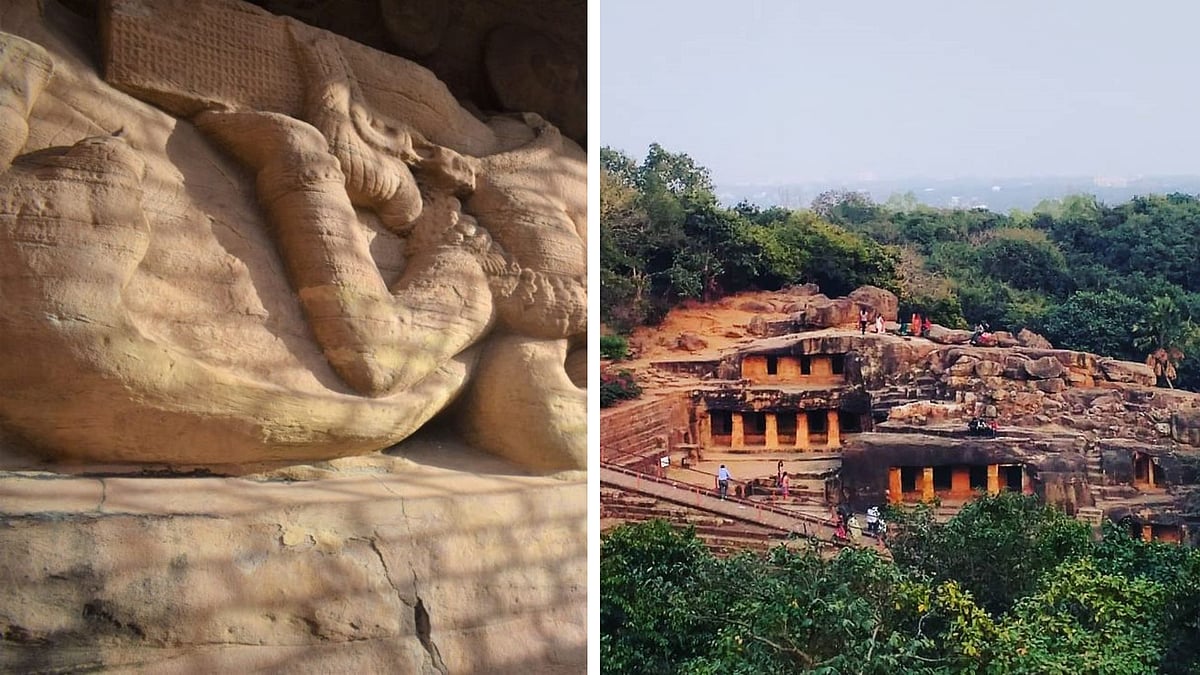Tome And Plume: Past Ever Present In Udayagiri Caves
Udayagiri means 'the sunrise mountain', where the first ray of the sun illuminates the hilltop

Tome And Plume: Past Ever Present In Udayagiri Caves |
Bhopal (Madhya Pradesh): The rivers Ganga and Yamuna, the two arteries of Madhyadesa, seem to have been adopted as the visible symbols par excellence of the homeland of the rising powers of the Guptas in the reign of Chandragupta II, Vikramaditya – VS Agarwala, historian
A trip to the Udayagiri hills, 60 km from the state capital, Bhopal, unveils the treasure of over 2,500-year-old history. Just as you enter the place, you whiff the fragrance of the past.
The Betwa River lazily rolls through the western part of the Udayagiri hills, and its tributary, the Bes River, also called the Halali River, flows through the eastern part of the mountains. The two rivers enhance the charm of the place.
There are trees on both sides of the road to Udayagiri. The solitude of the road and beeping birds soothe the ears of a traveller tired of honking cars.
Udayagiri means 'the sunrise mountain', where the first ray of the sun illuminates the hilltop. Because of its surroundings, Buddhism and Bhagvatism flourished at this place by the second century BCE. The Sanchi Stupa and the Heliodorus Pillar are evidence of it.
The Udayagiri hills consist of 20 rock-cut caves where a visitor can delve into the history and development of Hindu iconography. The rock-cut idols of Shiva, Vishnu, Lakshmi, and Bhudevi are there. These idols seem to be lively, though they are over 2,500 years old.
The most elegant of all the works is the rock-cut figurine of Anantashayana Vishnu reclining on Naga, or serpentine, which symbolises his eternal prowess. The hood of the serpent is providing him with the shade, and Vishnu holds his head on one of his four hands. Two other hands have been delineated touching his thighs. Yet, unlike the artwork in later centuries, Lakshmi is not shown holding his feet.
The ornaments, especially the crown, earrings, and necklace, are so finely carved that they look as if they are for real.
Below his left leg, a man is sitting with reverence, looking up to the Lord. Who is the man? Some historians say he can be any devotee, while others say the figure signifies the emperor, Chandragupta, who was a devotee of Vishnu.
Behind the seated man, another person has been depicted, who may be an attendant of the devotee. The Anantashayana figurine of the Lord is in cave number 13, which perhaps came up at the beginning of the fifth century CE.
Garuda, at the centre of the figure, has been depicted as a hawk-eagle-like bird. But the Udayagiri Hills were lying isolated for a long time, and a few scholars just mentioned them.
It was Vasudev Saran Agarwala who began to recognise that Udayagiri was a major religious centre during the Gupta period.
He also discovered that the deities were carved in conjunction with water cosmology, which was a turning point in the vocabulary of Indian art and architecture.
Initially, it was Alexander Cunningham who played an important role as the first archaeologist to study the caves in the 19th century and prepared the roadmap for the future research works on the caves.
Another fine figurine is seen in cave number five, a shallow rock-cut slot, which features the Varaha Avatar of Vishnu, who has been shown rescuing Bhu Devi, or the earth, from the cosmic ocean.
There are some remains of idols on the summit of the hills and on the slope. But their significance in archaeology is yet to be ferreted out. One day, the sunlight may unveil the mystery behind those structures that failed to weather the vagaries of nature.
[Story by Arup Chakraborty]
Published on: Saturday, October 04, 2025, 08:29 PM ISTRECENT STORIES
-
-
-
-
-